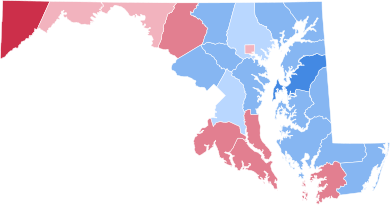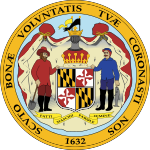| ||||||||||||||||||||||||||
| ||||||||||||||||||||||||||
 County Results
| ||||||||||||||||||||||||||
| ||||||||||||||||||||||||||
| Elections in Maryland |
|---|
 |
|
|
The 1908 United States presidential election in Maryland took place on November 3, 1908. All contemporary 46 states were part of the 1908 United States presidential election. State voters chose eight electors to the Electoral College, which selected the president and vice president.
After having voted for Republican William McKinley in 1896 and 1900, Maryland would become exceedingly close in 1904 with Alton B. Parker taking 7 of 8 electoral votes despite the highest Theodore Roosevelt elector beating any of Parker's by 51 votes. Large-scale immigration and efforts to reduce the solidly Republican Black vote were opposed for this election by dislike of William Jennings Bryan's populism in this urbanizing state.[1] At first, the latter trend appeared to be strong, and by the middle of September Taft's campaign managers thought Maryland was safe in his pocket,[2] although Bryan had campaigned in the state a few days previously.[3] This trend continued into early October as Roosevelt's war on Samuel Gompers was believed a major aid to Taft.[4] However, a new poll in the second week of October suggested the state could go to Bryan by 15,000 votes.[5] By election day, it was clear that Maryland would be almost as close as the 1904 election had proved.[6]
Maryland was won by the Democratic nominees, former Representative William Jennings Bryan of Nebraska and his running mate John W. Kern of Indiana, although the highest elector for Republican candidates William Howard Taft and James S. Sherman gained 605 more votes than the highest Bryan elector. This difference was supposedly due to the “Wilson Law” designed to make it easier for Democrats to cast ballots for both Presidential electors and Congress by a simple turning down of a single fold in the ballot paper.[7]
In this election, Maryland voted 8.28% more Democratic than the nation at-large.[8]
Cite error: There are <ref group=lower-alpha> tags or {{efn}} templates on this page, but the references will not show without a {{reflist|group=lower-alpha}} template or {{notelist}} template (see the help page).
- ^ Phillips, Kevin P.; The Emerging Republican Majority, pp. 29-35 ISBN 9780691163246
- ^ ‘Taft Workers Hear Maryland Is Safe – Secretary Hitchcock Cheered by News from the Congressional Committee’; New York Times, September 18, 1908. p. 3
- ^ ‘Bryan Makes Reply to Hearst’s Charge: Declares Statement That He Sought Political Trade with Editor Absolutely False’; New York Times, September 13, 1908, p. 3
- ^ ‘Helps in Maryland: President's War on Gompers Strong Aid to Taft – Every Gain Counts Large: Simplified Ballot Law Will Benefit the Republicans’; The Washington Post, October 5, 1908, p. 1
- ^ ‘President Worried about Labor Vote: James B. Reynolds, After Investigation, Reports Situation as Unsatisfactory’; New York Times, October 10, 1908, p. 4
- ^ ‘Very Close in Maryland: Taft and Bryan Alternate in Lead’; New York Times, November 5, 1908, p. 2
- ^ ‘Taft Gets Part of Maryland Vote – Trick Ballot Prevented Republicans from Getting a Big Plurality’; New York Times, November 6, 1908, p. 2
- ^ "Dave Leip's Atlas of U.S. Presidential Elections". uselectionatlas.org. Retrieved March 12, 2023.

